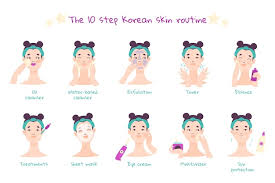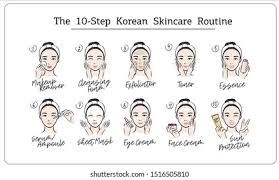
What is the Korean Skincare Routine ?
The Korean skincare routine, also known as “K-beauty,” is a step-by-step process that focuses on keeping the skin hydrated, cleaning it gently, and using natural ingredients to tackle specific skin issues. It’s popular around the world because it delivers great results, uses unique products, and is influenced by Korean culture.
Why is it popular world wide ?
Natural Ingredients:
Korean skincare uses natural ingredients like green tea, rice water, ginseng, and snail mucin to help nourish and improve the skin.
Multi-Step Approach:
The detailed, step-by-step routine is designed to promote the best skin health possible.
Cultural Influence:
Korean dramas and K-pop have made Korean beauty popular, inspiring many people to try K-beauty routines.
Innovative Products:
Korean skincare is known for its creative and new products that offer unique solutions.
Focus on Prevention:
Korean skincare focuses on preventing skin problems before they become bigger issues.
Effective Results:
By using natural ingredients and targeted treatments, Korean skincare gives noticeable improvements to the skin.
Versatile for Skin Types:
K-beauty offers products and routines that work for a variety of skin types and concerns.
Top 9 Steps in a Korean Skincare Routine

Double Cleansing : The Foundation of Korean skin care
- Double cleansing is a key part of the Korean skincare routine and involves two steps:
- Oil-based cleanser: This first step helps remove makeup, sunscreen, and excess oil.
- Water-based cleanser: The second step removes dirt and sweat, leaving your skin clean and fresh.
Double cleansing ensures your skin is thoroughly cleaned without stripping away its natural oils.
Exfoliation : Getting Rid of Dead Skin Cells
- Exfoliation is important to remove dead skin cells and encourage new skin growth. Be sure to use gentle exfoliants to avoid irritating your skin.
- Chemical exfoliants: These contain ingredients like AHA or BHA that dissolve dead skin cells.
- Physical exfoliants: These use scrubs or beads to physically rub off dead skin. Be careful, as these can be rough on your skin.
Exfoliate 2-3 times a week for most skin types, but listen to your skin’s needs.
Toner: The Unsung Hero of Korean Skincare
Toner helps restore your skin’s pH balance after cleansing. It’s not just for prepping the skin—it also hydrates and soothes it. A good toner replenishes moisture, calms irritation, and gets your skin ready for the next steps.
Essence: The Heart of the Korean Skincare Routine
Essence is a lightweight, hydrating liquid filled with active ingredients that deeply penetrate the skin to repair and refresh it. It’s considered the heart of the Korean skincare routine because it hydrates, brightens, and boosts skin health, preparing it for the heavier products to come.
Serum: Targeting Specific Skin Concerns
Serums are concentrated treatments that address specific skin issues like acne, pigmentation, or fine lines. There’s a serum for every skin concern, whether it’s for anti-aging or brightening.
The Magic of Sheet Masks
Sheet masks are soaked in a serum or essence and placed on your face for 15-20 minutes. They provide deep hydration and help calm and heal the skin. Using sheet masks 2-3 times a week can improve your skin’s texture and appearance.
Eye Cream: The Delicate Care for the Eyes
The skin around your eyes is thinner and more delicate than the rest of your face, which is why using an eye cream is important. Eye creams help reduce puffiness, dark circles, and fine lines, offering special care for the under-eye area.
Moisturizing: Locking in Hydration
Moisturizing is the last step in the Korean skincare routine. It helps your skin stay hydrated and prevents moisture loss throughout the day. There are different types of moisturizers, such as gel-based, cream-based, or emulsion-based, depending on your skin’s needs.
Sunscreen: The Final Step for Protecting Your Skin
Sunscreen is the most important step in any skincare routine. In Korea, sunscreen is used every day, even on cloudy days. It protects your skin from harmful UV rays, preventing premature aging and skin damage.
How to Adjust the Routine for Your Skin Type
1. Oily Skin
Go for light, gel-based moisturizers that won’t feel greasy.
Pick products labeled “oil-free” and “non-comedogenic” (which means they won’t clog your pores).
2. Dry Skin
Use thicker creams and hydrating serums to lock in moisture.
Try using a humidifier to add moisture to the air and keep your skin from drying out.
3. Combination Skin
Treat different parts of your face separately — use gel for oily areas and cream for dry spots.
4. Sensitive Skin
Stay away from products with fragrance and alcohol since they can irritate your skin.
Look for calming ingredients like aloe vera and chamomile.
Common Mistakes to Avoid
Skipping Sunscreen: Not using sunscreen can lead to faster skin aging and dark spots.
Exfoliating Too Much: Overdoing it can harm your skin and make it more sensitive.
Using Too Many Products: Layering too many products can overwhelm your skin and cause breakouts.
Suggested Daily Routine for Beginners
| Step | Product Type | Morning | Evening |
|---|
| 1 | Oil Cleanser | No | Yes |
| 2 | Water-Based Cleanser | Yes | Yes |
| 3 | Exfoliator | No | 2–3x/week |
| 4 | Toner | Yes | Yes |
| 5 | Essence | Yes | Yes |
| 6 | Serum | Yes | Yes |
| 7 | Sheet Mask | No | 1–2x/week |
| 8 | Eye Cream | Yes | Yes |
| 9 | Moisturizer | Yes | Yes |
| 10 | Sunscreen | Yes | No |

